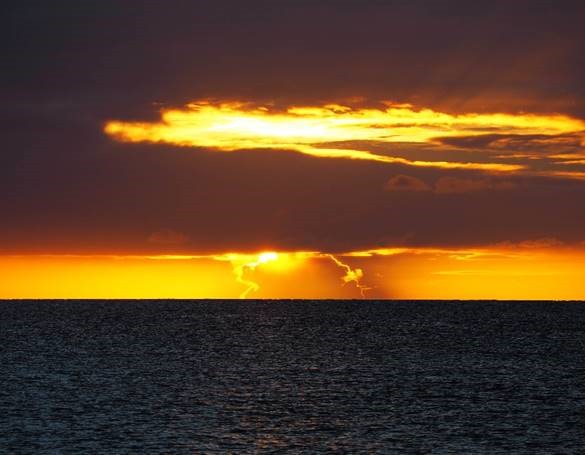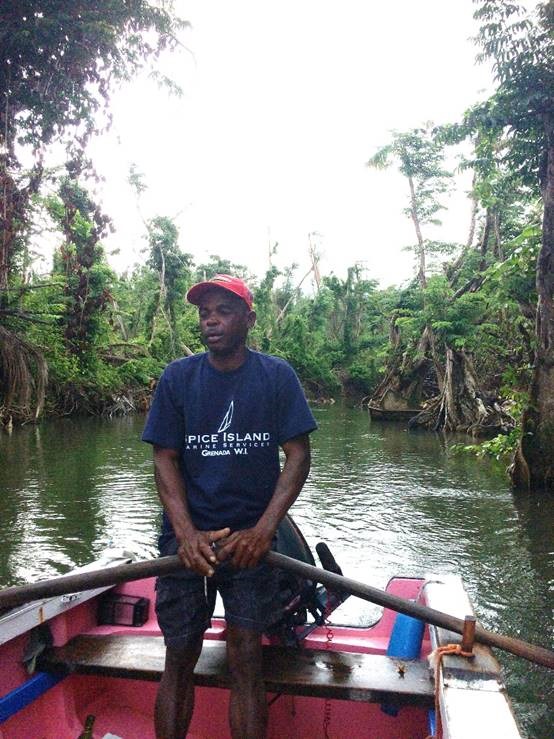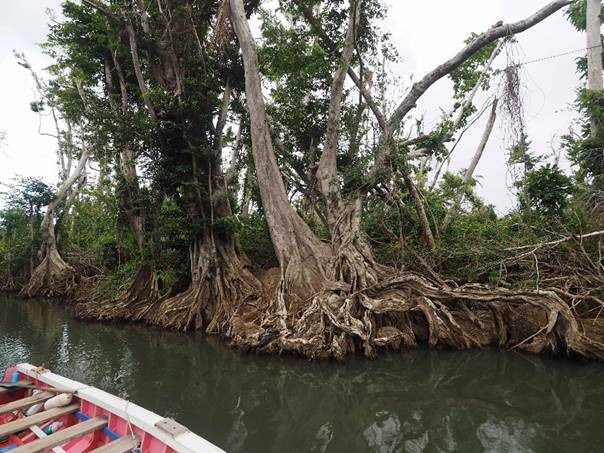28 Feb - Dominica: Bonto's story

|
15:34.6N 061:27.6W On Wednesday 28 February we were up early and met Bonto at 0700 to cruise up the Indian River in his boat. It’s a Nature Reserve, famous as the location of Calypso’s hut in the film ‘Pirates of the Caribbean’, for the beauty of the trees overhanging the river, the parrots feeding on the breadfruit, the exotic flora and fauna of a mangrove rainforest environment just yards from the town of Portsmouth. You cannot go up the river in your own boat and outboard motors are not allowed. Bonto rowed. It was beautifully still. One wall remains of Calypso’s hut – Bonto helped with the film but his own appearance was consigned to the cutting room floor. The overhanging trees have almost all gone – the one or two that remain have no foliage. There is no breadfruit, so no parrots. We saw a couple of large land crabs and some greenbacked herons. And a fine fluorescent green grasshopper about four inches long that Bonto found on a palm frond.
The beautiful Indian River. This is all that remains of the overhanging canopy of trees. Not the most forthcoming chap, he gradually warmed to us and told us something of his hurricane story. He survived the worst of it by sleeping in a cupboard. When he came out in the morning, it was all that remained of his home on the beach. He’s now living with his sister and ‘fixin’ up de place’ when funds and time allow. There is a shortage of raw materials and he was frustrated by the stockpiles that exist that are not being released. But overall he was pleased with the Dominican government’s response to the crisis and looks forward to a new country springing from the chaos. On the way back to Escapade, he showed us his house. It’s right on the beach next to a deserted warehouse. It reminded me of a shanty shack in a Brazilian favela, only not as smart. The zinc on the roof was secondhand. The plywood side panels were secondhand. As it stands, it will blow down in the next storm. You could get the whole thing out of a skip at your local Household Waste Disposal Site in sunny Hampshire. His view across the harbour and out to sea is priceless.
Another spectacular sunset… You cannot imagine how little he has, yet how stoic and determined to survive. After all, he has a boat with a working 25hp 2-stroke outboard, so unlike some of the other people we saw, at least he has some means of fending for himself. I gave him every brass screw I had, some nails and cup hooks that I found in a box of ‘come in handy’ fittings I’d brought from home, a handful of drill bits and as much cordage as I could spare. The spare boathook, a bagful of T-shirts and trousers. Two Victorian ornamental coat hooks that had been in my family home and which will look good on his shaky front door. We gave him £50 in cash. Nothing really… but he was really pleased and we parted firm friends. We plan to return to Dominica later in the deployment and see how he’s getting on.
Bonto: boat boy, Transatlantic sailor and survivor We sailed later that morning for the Iles des Saintes, just south of Guadeloupe. He went off ‘to find another yacht’. So, what do we draw from all this? Unlike the French sovereign territories a few miles to the north and south which seem to have either avoided catastrophe or recovered very quickly, Dominica is independent and church mouse poor. The economy depends on bananas and specialist tourism – and there’s little of either at the moment so the treasury coffers must be reliant on international aid. There were signs of this, but most of the activity we saw was definitely in the ‘self help’ category. There is a huge amount of clearing up still to do; and for tourism to return as a viable part of the economy, they need to focus on a reliable electricity supply and the repair of the wonderful walking trails. This is, after all, quite possibly the only island that Columbus would recognise and a place of staggering natural beauty. There are a host of questions that fall from this brief snapshot. Where are the Chinese? Why aren’t those American students back in country working in the local community? What did our own DfID do? What’s the plan for restoring electricity? What about those trail routes? What about those people without insurance – who’s helping them fix their houses? The population was knocked flat and looks to be back on its knees today, so perhaps the time for ‘sticking plaster aid’ is over? There were signs of international aid, but also signs of bureaucratic stagnation, no doubt overwhelmed by the sheer scale of the task at hand. There is no doubt that huge progress has been made since the immediate aftermath of Maria: the photographs in the media from November 2017 are startlingly different to the ones we took. I’m not an expert and I have no sight of the ‘grand plan’ if there is one, but IMHO this island needs a huge, sustained investment in expertise to rejuvenate the strata of local government just as much as it needs copper wire, nails, wood and aluminium sheeting. Prime Minister Skerritt has a great vision for the future, but it will cost roughly twice his annual GDP just to restore the status quo. I might well have looked in the wrong places, but I didn’t see the army of aid workers, planners and technicians that I was expecting. Instead I met people without homes and without the physical means of rebuilding them – a shortage of cashflow and basic raw materials. I wonder about the potential for links between Portsmouth, Hampshire and Portsmouth, Dominica. There must be something positive that could come from closer ties between the two places which share so much of the history of the Royal Navy and maritime affairs. I wonder whether this might spawn links between organisations like the Portsmouth and Langstone Sailing Association and the guys at Portsmouth Association of Yacht Services, for example? Fundamentally, I sense that relatively small amounts of money targeted directly at specific groups of people could achieve faster, more tangible results at a local, grassroots level than larger sums channelled through larger aid organisations that may be weighed down by officialdom and concerns over accountability. There’s room (and a clear need) for both, particularly to build in longer-term resilience. But how to set in motion the lower level, more practical stuff? And who needs it most? I plan to ask the Ocean Cruising Club how they went about helping PAYS to renew their moorings. I need to find out which NGOs are operating on the ground and what their projects are. I need to find out who the local ‘movers and shakers’ are in Portsmouth, Dominica. Our visit to Dominica was very short and made a huge impact on us both. I know that the same is true for a number of other yachtsmen who we have spoken to. In just a few hours ashore, we saw a fraction of the challenge facing the government and the man in the street. We felt inspired to DO SOMETHING and sense that there is a gap in the official response that could and should be plugged. We now need to do more research into the issues and opportunities that arise before trying to galvanise an army into action. If you have ideas or information that could help, please get in touch.
It will take more than a couple of hurricanes to dislodge this amazing root system in the Indian River.
|



